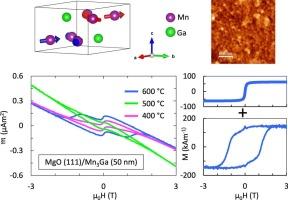在顺磁性和抗磁性MgO(111)衬底上生长的外延D019-Mn3Ga薄膜
IF 4.6
2区 物理与天体物理
Q2 MATERIALS SCIENCE, MULTIDISCIPLINARY
引用次数: 0
摘要
采用射频磁控溅射技术在MgO(111)衬底上生长了50 nm厚的D019-Mn3Ga外延薄膜。结构表征表明,在400°C和500°C下生长的薄膜具有单晶性质,而在600°C下生长的薄膜则表现为外延镶嵌状生长,并伴有四角形D022相的结晶。磁性测量证明了衬底的抗磁性和顺磁性贡献的存在,顺磁性贡献可能是由于原子浓度低于1%的磁性杂质。我们在磁化-磁场和磁化-温度曲线中都去掉了这些贡献。修正后,D019- mn3ga薄膜的磁环被分解为反铁磁性和铁磁性组分,利用布里因函数,该函数是由Mn原子的磁矩倾斜和D019相的kagome自旋结构的畸变引起的,在单晶畴之间的边界以及D022团簇的铁磁性贡献。本文章由计算机程序翻译,如有差异,请以英文原文为准。

Epitaxial D019-Mn3Ga thin films grown on the paramagnetic and diamagnetic MgO (111) substrate
50 nm-thick D019-Mn3Ga epitaxial thin films were grown on MgO (111) substrates by rf-magnetron sputtering. Structural characterization demonstrated the single crystalline nature of the films grown at 400 and 500 °C, while those grown at 600 °C show an epitaxial mosaic-like growth together with the crystallization of the tetragonal D022 phase. The magnetic measurements evidenced the presence of diamagnetic and paramagnetic contributions due to the substrate, with the paramagnetic contribution probably due to magnetic impurities with concentration below 1 % atomic. We removed those contributions in both the magnetization-magnetic field and magnetization-temperature curves. After that correction, the magnetic loops of the D019-Mn3Ga thin films were decomposed in antiferromagnetic and ferromagnetic components, employing the Brillouin function, the latest arising from the canting of the magnetic moment of the Mn atoms and the distortion of the kagome spin structure, of the D019 phase, at the boundaries between single crystalline domains as well as the ferrimagnetic contribution of the D022 clusters.
求助全文
通过发布文献求助,成功后即可免费获取论文全文。
去求助
来源期刊

Results in Physics
MATERIALS SCIENCE, MULTIDISCIPLINARYPHYSIC-PHYSICS, MULTIDISCIPLINARY
CiteScore
8.70
自引率
9.40%
发文量
754
审稿时长
50 days
期刊介绍:
Results in Physics is an open access journal offering authors the opportunity to publish in all fundamental and interdisciplinary areas of physics, materials science, and applied physics. Papers of a theoretical, computational, and experimental nature are all welcome. Results in Physics accepts papers that are scientifically sound, technically correct and provide valuable new knowledge to the physics community. Topics such as three-dimensional flow and magnetohydrodynamics are not within the scope of Results in Physics.
Results in Physics welcomes three types of papers:
1. Full research papers
2. Microarticles: very short papers, no longer than two pages. They may consist of a single, but well-described piece of information, such as:
- Data and/or a plot plus a description
- Description of a new method or instrumentation
- Negative results
- Concept or design study
3. Letters to the Editor: Letters discussing a recent article published in Results in Physics are welcome. These are objective, constructive, or educational critiques of papers published in Results in Physics. Accepted letters will be sent to the author of the original paper for a response. Each letter and response is published together. Letters should be received within 8 weeks of the article''s publication. They should not exceed 750 words of text and 10 references.
 求助内容:
求助内容: 应助结果提醒方式:
应助结果提醒方式:


